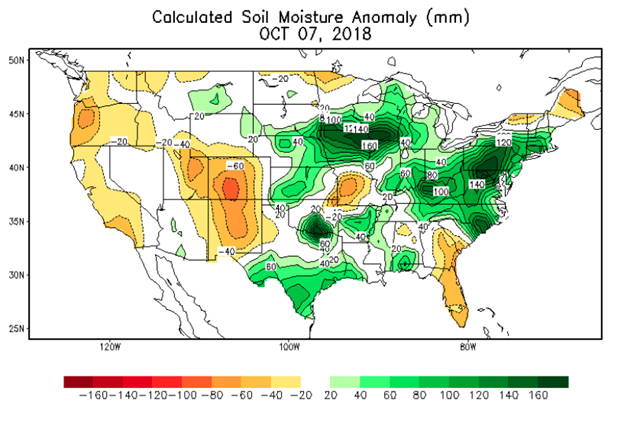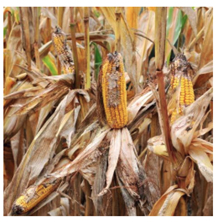Soggy conditions have slowed field work and narrowed the gap between this year’s progress and the five-year average. Days suitable for field work in the week ended October 7 ranged from 1.6 in Iowa to 1.9 in South Dakota, 3.2 in Nebraska and 4.6 in Kansas.
Corn harvest progressed to 34 percent, compared with 26 percent on average in the 18 states and soybeans, at 32 percent, trailed the average by four points.
| Oct. 7, 2018 |
CORN |
SOYBEANS |
|
Percent harvested |
Points gained in week |
Average |
Percent harvested |
Points gained in week |
Average |
| Iowa |
15 |
4 |
13 |
18 |
3 |
31 |
| Kansas |
59 |
12 |
52 |
14 |
7 |
19 |
| Nebraska |
23 |
6 |
6 |
36 |
9 |
33 |
| South Dakota |
16 |
5 |
5 |
28 |
7 |
41 |
Corn and soybean condition in the 18 states was unchanged other than a loss of one percentage point on the high end for corn. Corn was rated 12 percent poor/very poor and 68 percent good/excellent; soybeans, 10 percent and 68 percent.
Sorghum harvest is complete in Kansas (equal to average), 23 percent complete in Nebraska (16 percent average), and two points behind average in South Dakota at 16 percent.
Soggy soils
Just as farmers were frustrated by wet fields at the start of planting, they are experiencing similar difficulties at harvest. The map below shows soil moisture in large portions of the Corn Belt and our service area are 40 to 160 millimeters above normal.

 Plant diseases related to moisture, including northern corn leaf blight, gray leaf spot and tar spot, as well as Fusarium and Gibberella ear rots, are a concern in high-moisture areas. Lodged corn is at particular risk for developing mycotoxins.
Plant diseases related to moisture, including northern corn leaf blight, gray leaf spot and tar spot, as well as Fusarium and Gibberella ear rots, are a concern in high-moisture areas. Lodged corn is at particular risk for developing mycotoxins.
Producers are encouraged to inspect their fields before harvest for signs of mold or mycotoxins. It’s important to work with your crop insurance agent to arrange an inspection of the field.
For those cutting silage, concerns caused by early plant maturity combined with inability to get into soggy fields go beyond mold and mycotoxins, which can develop and grow in storage. These include:
- Higher dry matter silage: If dry matter is more than 40 percent, the digestibility of fiber and starch are reduced;
- Less dense packing and greater oxygen content
South Dakota State University Extension offers the tips to improve results.
Looking ahead, an El Nino is likely in the weeks and months ahead. That points to a warmer than average winter in our service area. The Southwest and Southern Plains could see above normal precipitation. So much so in fact that during a webinar for our customers, Mike Murphy of Cattlefax predicted soil moisture in Texas and Oklahoma “could be fine by next spring.”

